ACC707 Audit Assignment: Inventory and Intellectual Property Analysis
VerifiedAdded on 2023/06/04
|14
|3009
|342
Report
AI Summary
This assignment report provides a comprehensive analysis of audit assertions, procedures, and key audit matters related to inventory valuation and intellectual property rights. It examines the risks associated with inventory valuation, including obsolescence and ownership, and outlines substantive audit procedures to address these risks. The report also discusses the importance of intellectual property valuation in today's business environment, highlighting key assertions at risk and the audit procedures required. Furthermore, it explores the application of ASA 701, emphasizing the importance of key audit matters and disclosures in the audit report. The report includes an analysis of a case study of Computing Solutions Limited and extracts from the annual report of Woolworths Corporation to illustrate the practical application of audit principles.
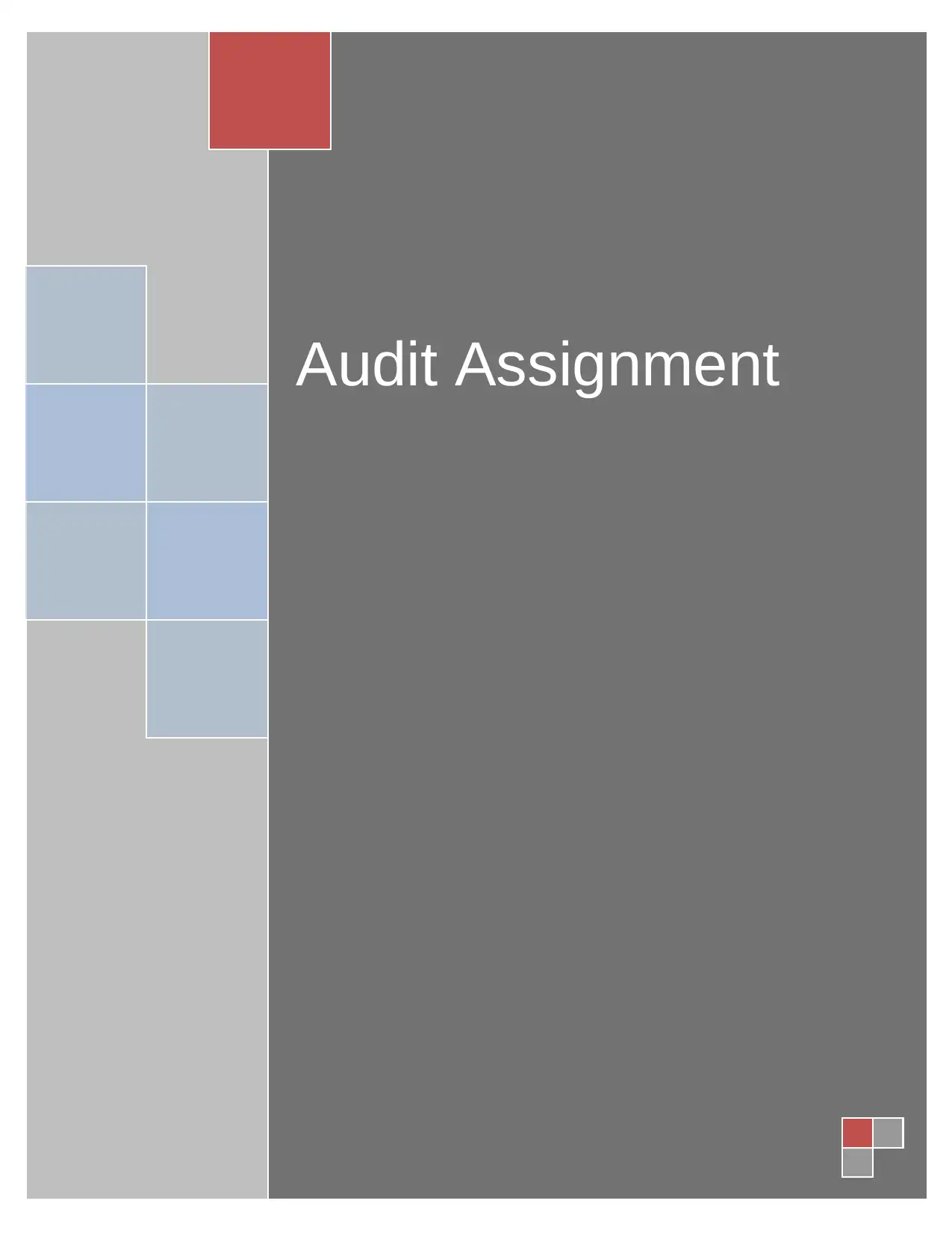
Audit Assignment
Paraphrase This Document
Need a fresh take? Get an instant paraphrase of this document with our AI Paraphraser
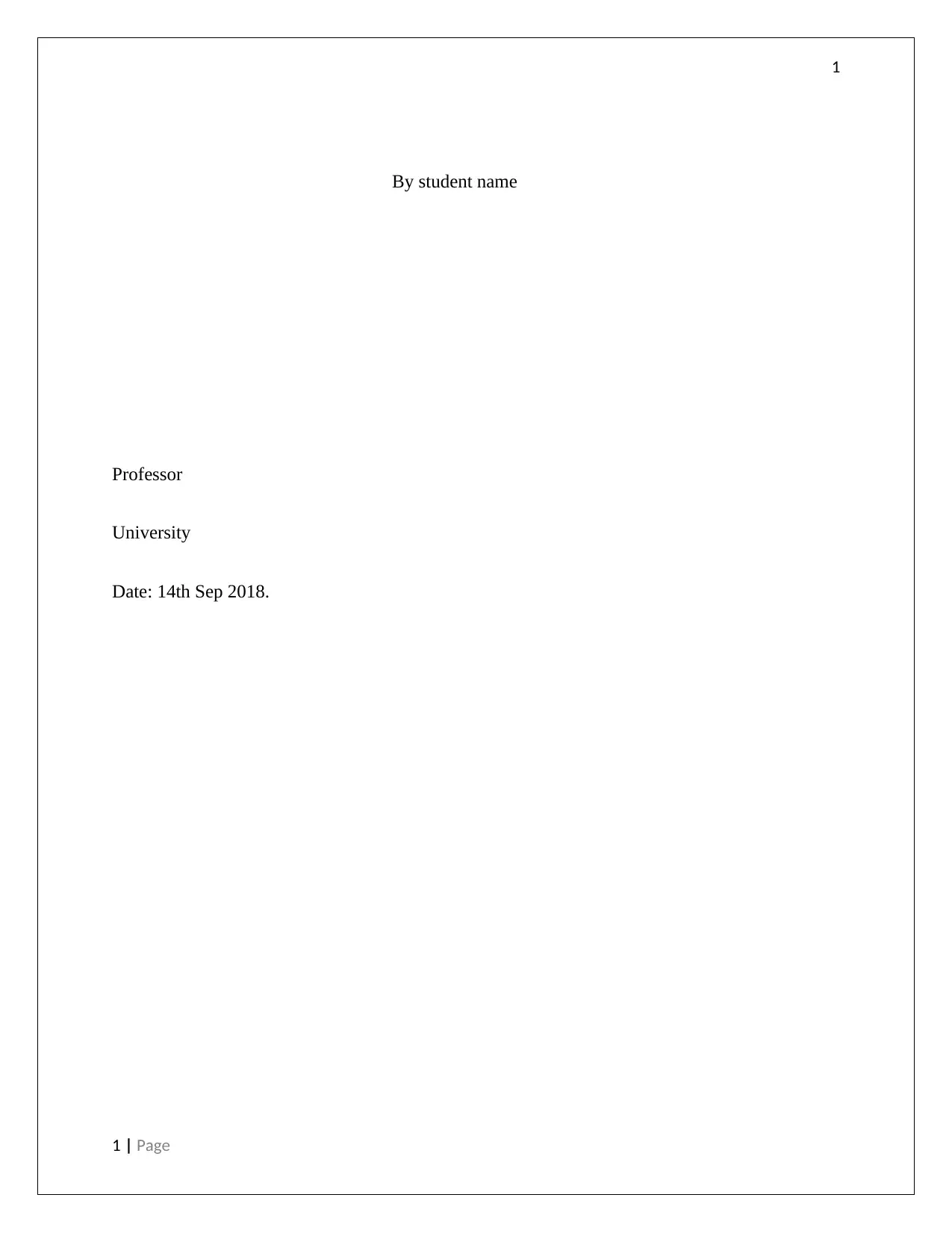
1
By student name
Professor
University
Date: 14th Sep 2018.
1 | Page
By student name
Professor
University
Date: 14th Sep 2018.
1 | Page
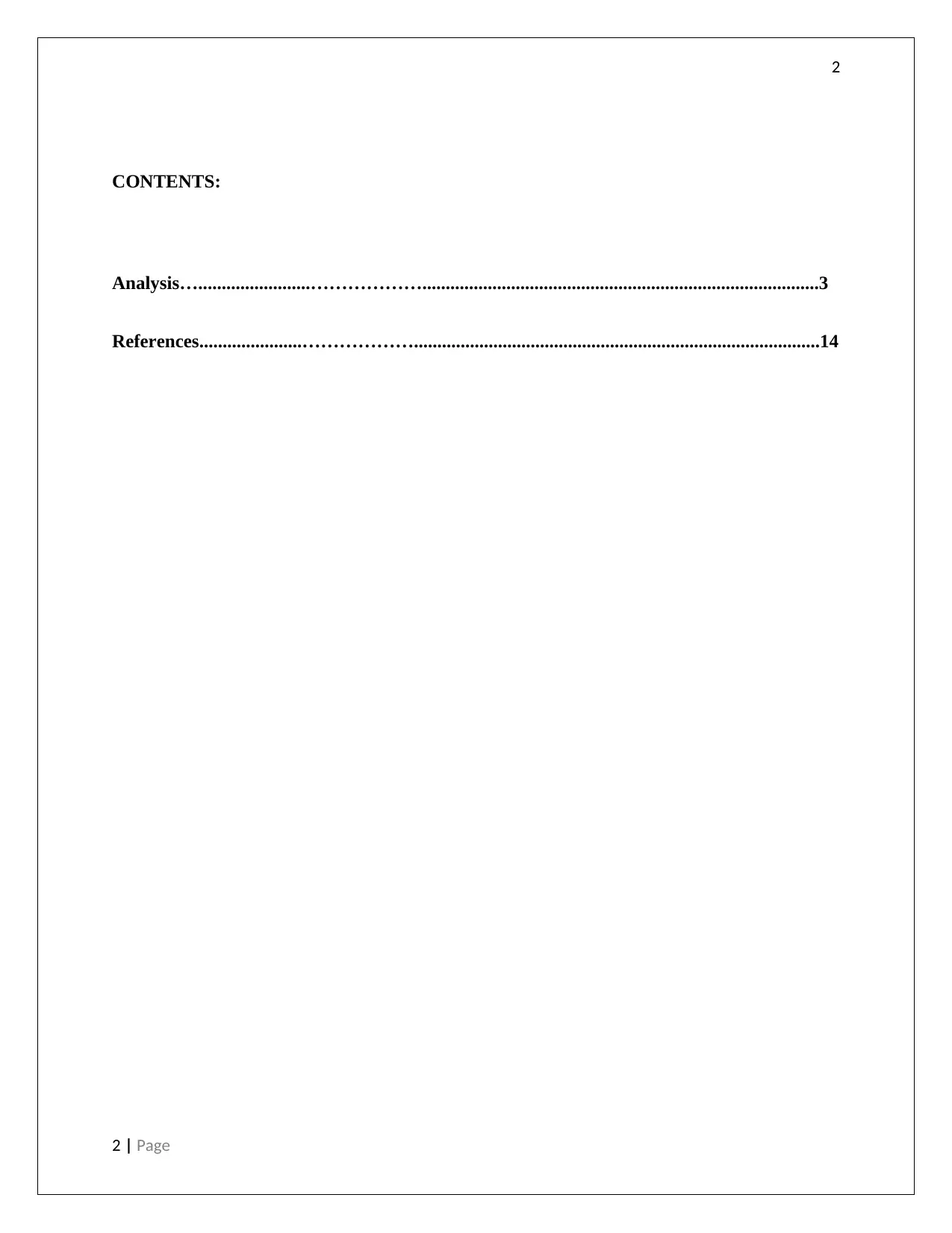
2
CONTENTS:
Analysis…........................……………….....................................................................................3
References......................……………….......................................................................................14
2 | Page
CONTENTS:
Analysis…........................……………….....................................................................................3
References......................……………….......................................................................................14
2 | Page
⊘ This is a preview!⊘
Do you want full access?
Subscribe today to unlock all pages.

Trusted by 1+ million students worldwide

3
Audit Assertion
Audit assertion refers to the process of including certain matters while conducting an audit which
the management thinks to be detrimental for the success of the company and for maintenance of
overall fairness. These assertions mainly emphasises on matters relating to recognising the value
and presentation of financial data of the company. Based on the above and several other factors,
audit assertion, which is better known as financial statement assertion or assertion of the
management, are divided into several other categories- accuracy, materiality, valuation,
completeness, occurrence, obligations, etc. These assertions help the auditor to solve major
issues affecting his work in general and also other large issues that affects the audit process.
There are four main kinds of assertions in case of a balance sheet namely completeness,
accuracy, rights and obligations. In this assignment, valuation of inventories and related
assertions are stated in detail. The risks relating to audit assertions of the valuation of inventories
have been highlighted below:
1 a) key assertions at risk
Valuation: This is the most important assertion that the company must make in case of
inventories. The inventories are generally valued at lower of historical cost or the net realisable
value. Moreover, abnormal loss or wastage should be excluded while valuing inventory. Only
losses which are normal in nature are considered for valuation. Valuation of work in progress
goods is very difficult. In this case, the company deals in computer appliances and parts relating
to the same, which increases the chances of inventory becoming obsolete or not usable in future
3 | Page
Audit Assertion
Audit assertion refers to the process of including certain matters while conducting an audit which
the management thinks to be detrimental for the success of the company and for maintenance of
overall fairness. These assertions mainly emphasises on matters relating to recognising the value
and presentation of financial data of the company. Based on the above and several other factors,
audit assertion, which is better known as financial statement assertion or assertion of the
management, are divided into several other categories- accuracy, materiality, valuation,
completeness, occurrence, obligations, etc. These assertions help the auditor to solve major
issues affecting his work in general and also other large issues that affects the audit process.
There are four main kinds of assertions in case of a balance sheet namely completeness,
accuracy, rights and obligations. In this assignment, valuation of inventories and related
assertions are stated in detail. The risks relating to audit assertions of the valuation of inventories
have been highlighted below:
1 a) key assertions at risk
Valuation: This is the most important assertion that the company must make in case of
inventories. The inventories are generally valued at lower of historical cost or the net realisable
value. Moreover, abnormal loss or wastage should be excluded while valuing inventory. Only
losses which are normal in nature are considered for valuation. Valuation of work in progress
goods is very difficult. In this case, the company deals in computer appliances and parts relating
to the same, which increases the chances of inventory becoming obsolete or not usable in future
3 | Page
Paraphrase This Document
Need a fresh take? Get an instant paraphrase of this document with our AI Paraphraser
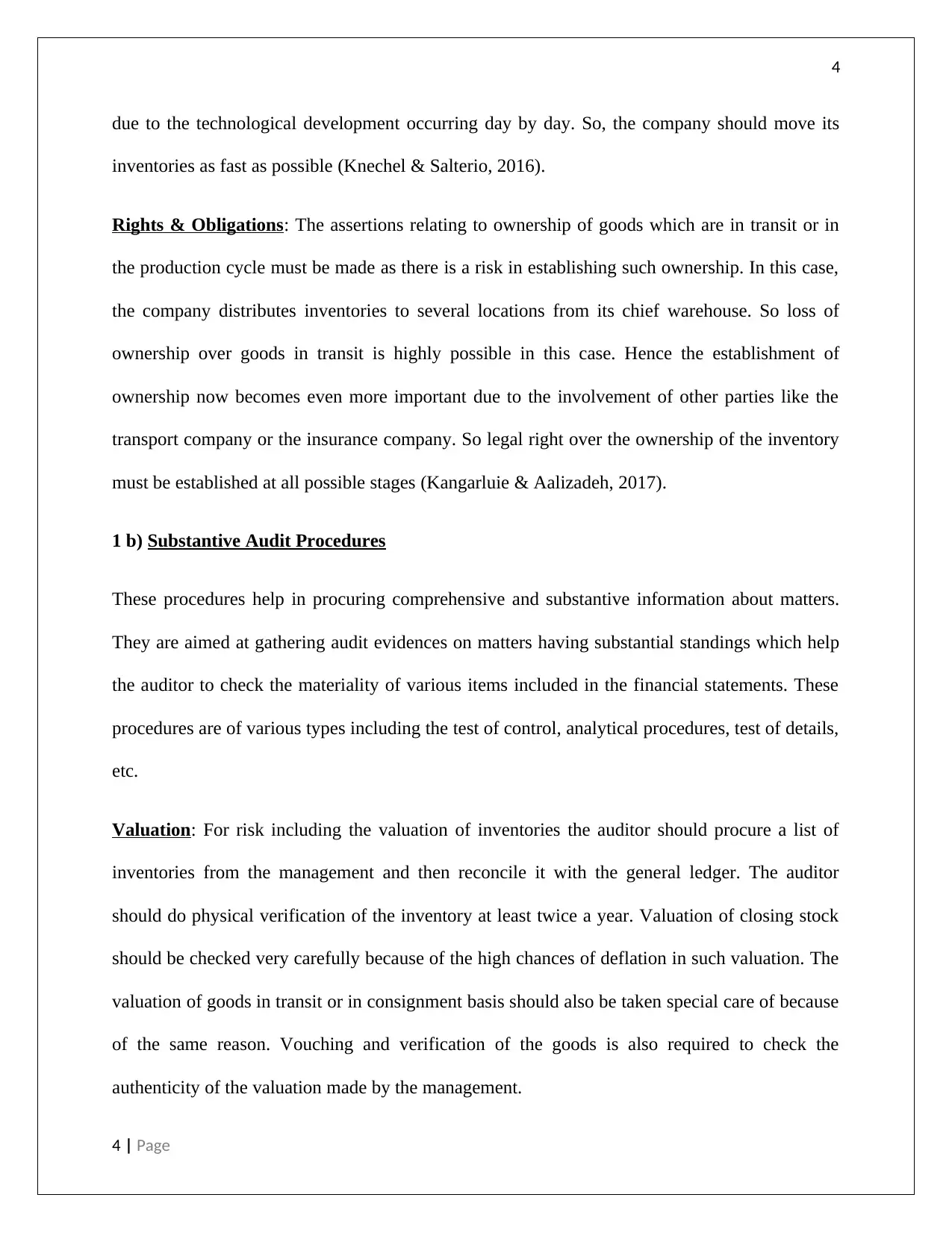
4
due to the technological development occurring day by day. So, the company should move its
inventories as fast as possible (Knechel & Salterio, 2016).
Rights & Obligations: The assertions relating to ownership of goods which are in transit or in
the production cycle must be made as there is a risk in establishing such ownership. In this case,
the company distributes inventories to several locations from its chief warehouse. So loss of
ownership over goods in transit is highly possible in this case. Hence the establishment of
ownership now becomes even more important due to the involvement of other parties like the
transport company or the insurance company. So legal right over the ownership of the inventory
must be established at all possible stages (Kangarluie & Aalizadeh, 2017).
1 b) Substantive Audit Procedures
These procedures help in procuring comprehensive and substantive information about matters.
They are aimed at gathering audit evidences on matters having substantial standings which help
the auditor to check the materiality of various items included in the financial statements. These
procedures are of various types including the test of control, analytical procedures, test of details,
etc.
Valuation: For risk including the valuation of inventories the auditor should procure a list of
inventories from the management and then reconcile it with the general ledger. The auditor
should do physical verification of the inventory at least twice a year. Valuation of closing stock
should be checked very carefully because of the high chances of deflation in such valuation. The
valuation of goods in transit or in consignment basis should also be taken special care of because
of the same reason. Vouching and verification of the goods is also required to check the
authenticity of the valuation made by the management.
4 | Page
due to the technological development occurring day by day. So, the company should move its
inventories as fast as possible (Knechel & Salterio, 2016).
Rights & Obligations: The assertions relating to ownership of goods which are in transit or in
the production cycle must be made as there is a risk in establishing such ownership. In this case,
the company distributes inventories to several locations from its chief warehouse. So loss of
ownership over goods in transit is highly possible in this case. Hence the establishment of
ownership now becomes even more important due to the involvement of other parties like the
transport company or the insurance company. So legal right over the ownership of the inventory
must be established at all possible stages (Kangarluie & Aalizadeh, 2017).
1 b) Substantive Audit Procedures
These procedures help in procuring comprehensive and substantive information about matters.
They are aimed at gathering audit evidences on matters having substantial standings which help
the auditor to check the materiality of various items included in the financial statements. These
procedures are of various types including the test of control, analytical procedures, test of details,
etc.
Valuation: For risk including the valuation of inventories the auditor should procure a list of
inventories from the management and then reconcile it with the general ledger. The auditor
should do physical verification of the inventory at least twice a year. Valuation of closing stock
should be checked very carefully because of the high chances of deflation in such valuation. The
valuation of goods in transit or in consignment basis should also be taken special care of because
of the same reason. Vouching and verification of the goods is also required to check the
authenticity of the valuation made by the management.
4 | Page
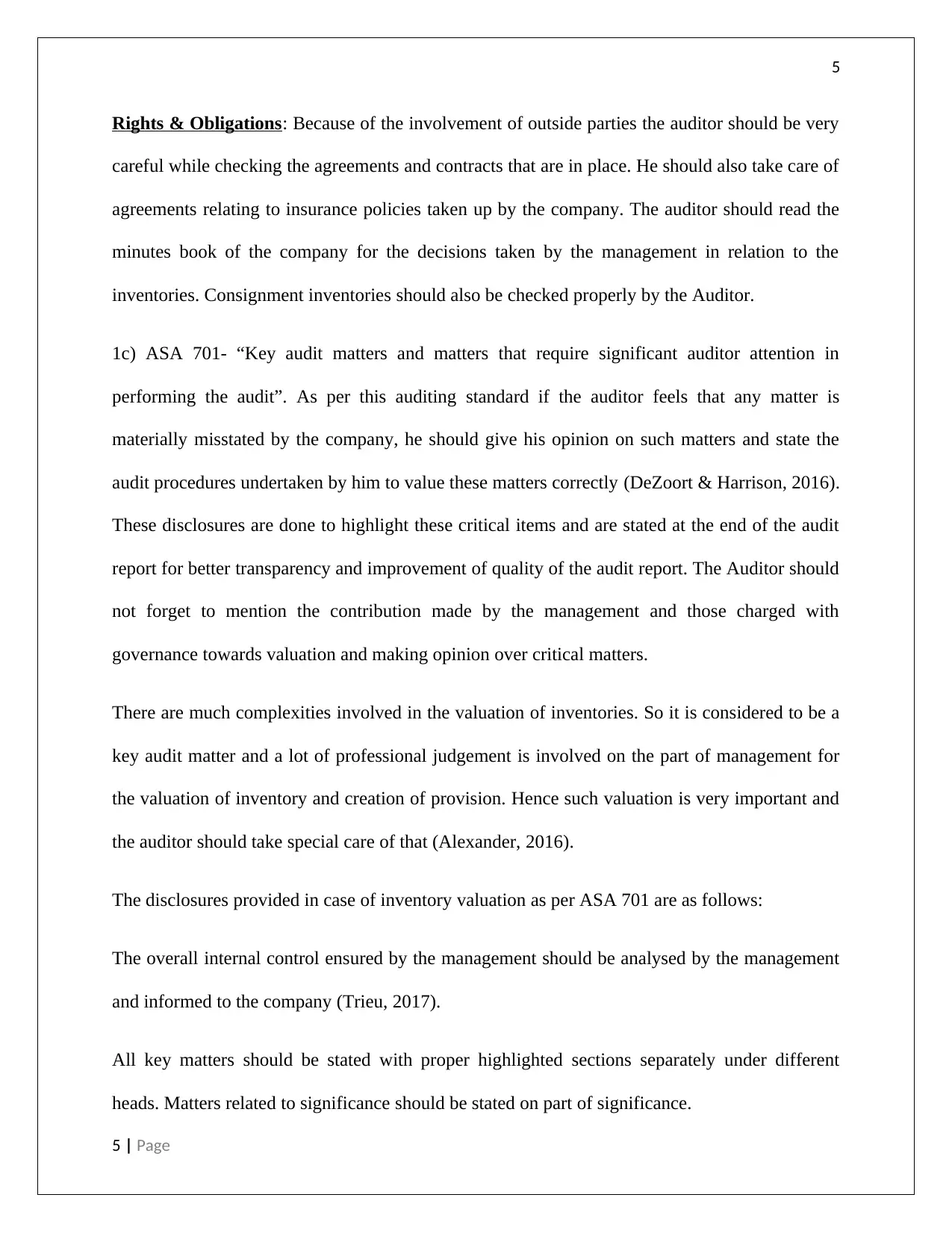
5
Rights & Obligations: Because of the involvement of outside parties the auditor should be very
careful while checking the agreements and contracts that are in place. He should also take care of
agreements relating to insurance policies taken up by the company. The auditor should read the
minutes book of the company for the decisions taken by the management in relation to the
inventories. Consignment inventories should also be checked properly by the Auditor.
1c) ASA 701- “Key audit matters and matters that require significant auditor attention in
performing the audit”. As per this auditing standard if the auditor feels that any matter is
materially misstated by the company, he should give his opinion on such matters and state the
audit procedures undertaken by him to value these matters correctly (DeZoort & Harrison, 2016).
These disclosures are done to highlight these critical items and are stated at the end of the audit
report for better transparency and improvement of quality of the audit report. The Auditor should
not forget to mention the contribution made by the management and those charged with
governance towards valuation and making opinion over critical matters.
There are much complexities involved in the valuation of inventories. So it is considered to be a
key audit matter and a lot of professional judgement is involved on the part of management for
the valuation of inventory and creation of provision. Hence such valuation is very important and
the auditor should take special care of that (Alexander, 2016).
The disclosures provided in case of inventory valuation as per ASA 701 are as follows:
The overall internal control ensured by the management should be analysed by the management
and informed to the company (Trieu, 2017).
All key matters should be stated with proper highlighted sections separately under different
heads. Matters related to significance should be stated on part of significance.
5 | Page
Rights & Obligations: Because of the involvement of outside parties the auditor should be very
careful while checking the agreements and contracts that are in place. He should also take care of
agreements relating to insurance policies taken up by the company. The auditor should read the
minutes book of the company for the decisions taken by the management in relation to the
inventories. Consignment inventories should also be checked properly by the Auditor.
1c) ASA 701- “Key audit matters and matters that require significant auditor attention in
performing the audit”. As per this auditing standard if the auditor feels that any matter is
materially misstated by the company, he should give his opinion on such matters and state the
audit procedures undertaken by him to value these matters correctly (DeZoort & Harrison, 2016).
These disclosures are done to highlight these critical items and are stated at the end of the audit
report for better transparency and improvement of quality of the audit report. The Auditor should
not forget to mention the contribution made by the management and those charged with
governance towards valuation and making opinion over critical matters.
There are much complexities involved in the valuation of inventories. So it is considered to be a
key audit matter and a lot of professional judgement is involved on the part of management for
the valuation of inventory and creation of provision. Hence such valuation is very important and
the auditor should take special care of that (Alexander, 2016).
The disclosures provided in case of inventory valuation as per ASA 701 are as follows:
The overall internal control ensured by the management should be analysed by the management
and informed to the company (Trieu, 2017).
All key matters should be stated with proper highlighted sections separately under different
heads. Matters related to significance should be stated on part of significance.
5 | Page
⊘ This is a preview!⊘
Do you want full access?
Subscribe today to unlock all pages.

Trusted by 1+ million students worldwide

6
The Auditor should explain properly as to why this matter is important and should make an
assurance in clear terms that the valuation of inventories is correct. There should be high
knowledge and understanding between the Auditor and the company for smooth movement of
the audit process (Bromwich & Scapens, 2016).
In case of any key audit matter if the Auditor does not feel the need of any explanation, he
should state it briefly in clear terms. Disclosures relating to any matter which is not stated in the
audit report must be made by the company as it may be useful for the users to analyse these key
matters. This is because there are high chances of material misstatement in these matters which
involves high risk on the part of the investors.
For assessing the KAM, the annual report of Woolworths Corporation has been downloaded and
an extract of the same is given.
With respect to provisioning of inventory the auditor has considered this as a key audit matter for
the company, and has highlighted the procedures they have adopted to analyze them. It can be
6 | Page
The Auditor should explain properly as to why this matter is important and should make an
assurance in clear terms that the valuation of inventories is correct. There should be high
knowledge and understanding between the Auditor and the company for smooth movement of
the audit process (Bromwich & Scapens, 2016).
In case of any key audit matter if the Auditor does not feel the need of any explanation, he
should state it briefly in clear terms. Disclosures relating to any matter which is not stated in the
audit report must be made by the company as it may be useful for the users to analyse these key
matters. This is because there are high chances of material misstatement in these matters which
involves high risk on the part of the investors.
For assessing the KAM, the annual report of Woolworths Corporation has been downloaded and
an extract of the same is given.
With respect to provisioning of inventory the auditor has considered this as a key audit matter for
the company, and has highlighted the procedures they have adopted to analyze them. It can be
6 | Page
Paraphrase This Document
Need a fresh take? Get an instant paraphrase of this document with our AI Paraphraser
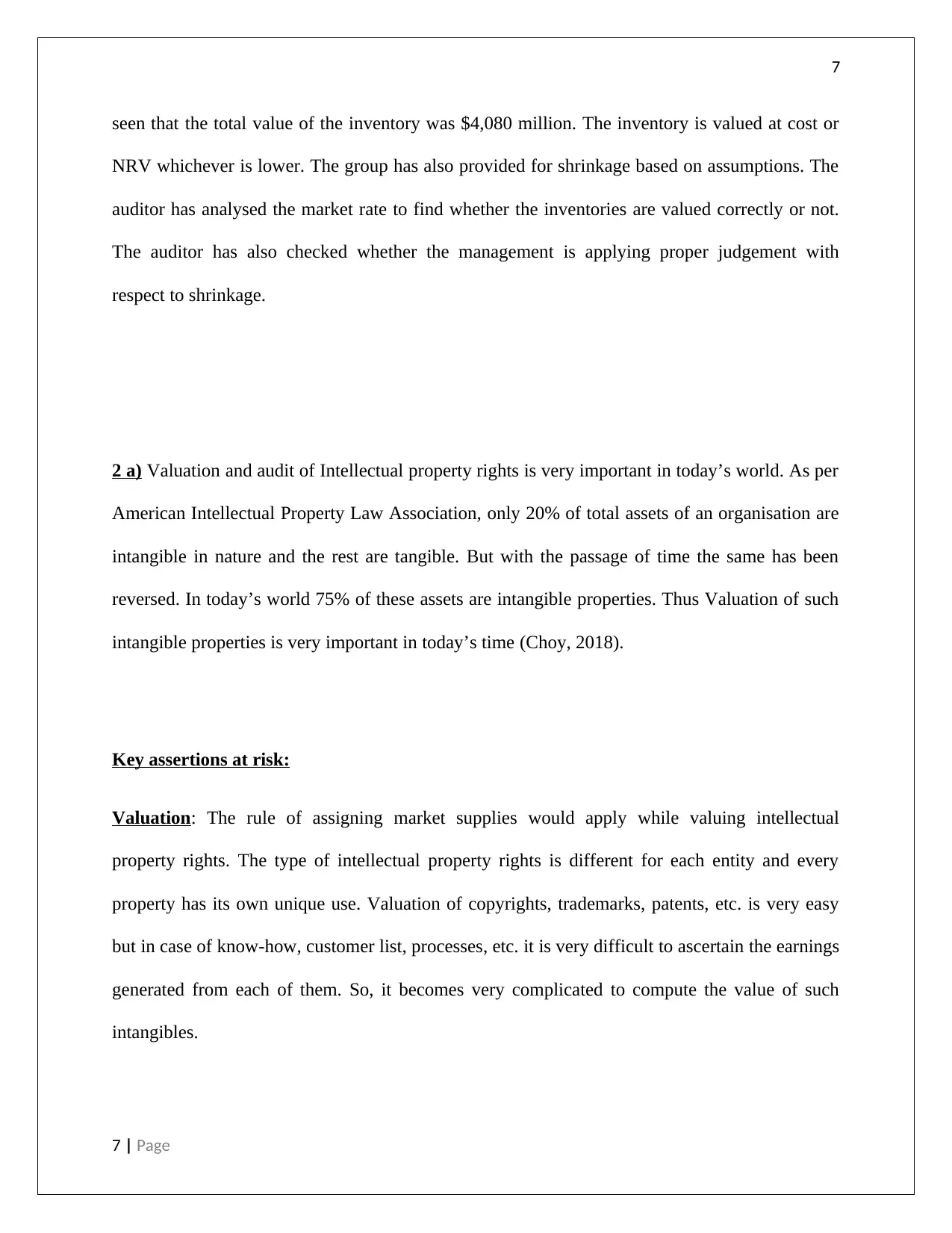
7
seen that the total value of the inventory was $4,080 million. The inventory is valued at cost or
NRV whichever is lower. The group has also provided for shrinkage based on assumptions. The
auditor has analysed the market rate to find whether the inventories are valued correctly or not.
The auditor has also checked whether the management is applying proper judgement with
respect to shrinkage.
2 a) Valuation and audit of Intellectual property rights is very important in today’s world. As per
American Intellectual Property Law Association, only 20% of total assets of an organisation are
intangible in nature and the rest are tangible. But with the passage of time the same has been
reversed. In today’s world 75% of these assets are intangible properties. Thus Valuation of such
intangible properties is very important in today’s time (Choy, 2018).
Key assertions at risk:
Valuation: The rule of assigning market supplies would apply while valuing intellectual
property rights. The type of intellectual property rights is different for each entity and every
property has its own unique use. Valuation of copyrights, trademarks, patents, etc. is very easy
but in case of know-how, customer list, processes, etc. it is very difficult to ascertain the earnings
generated from each of them. So, it becomes very complicated to compute the value of such
intangibles.
7 | Page
seen that the total value of the inventory was $4,080 million. The inventory is valued at cost or
NRV whichever is lower. The group has also provided for shrinkage based on assumptions. The
auditor has analysed the market rate to find whether the inventories are valued correctly or not.
The auditor has also checked whether the management is applying proper judgement with
respect to shrinkage.
2 a) Valuation and audit of Intellectual property rights is very important in today’s world. As per
American Intellectual Property Law Association, only 20% of total assets of an organisation are
intangible in nature and the rest are tangible. But with the passage of time the same has been
reversed. In today’s world 75% of these assets are intangible properties. Thus Valuation of such
intangible properties is very important in today’s time (Choy, 2018).
Key assertions at risk:
Valuation: The rule of assigning market supplies would apply while valuing intellectual
property rights. The type of intellectual property rights is different for each entity and every
property has its own unique use. Valuation of copyrights, trademarks, patents, etc. is very easy
but in case of know-how, customer list, processes, etc. it is very difficult to ascertain the earnings
generated from each of them. So, it becomes very complicated to compute the value of such
intangibles.
7 | Page
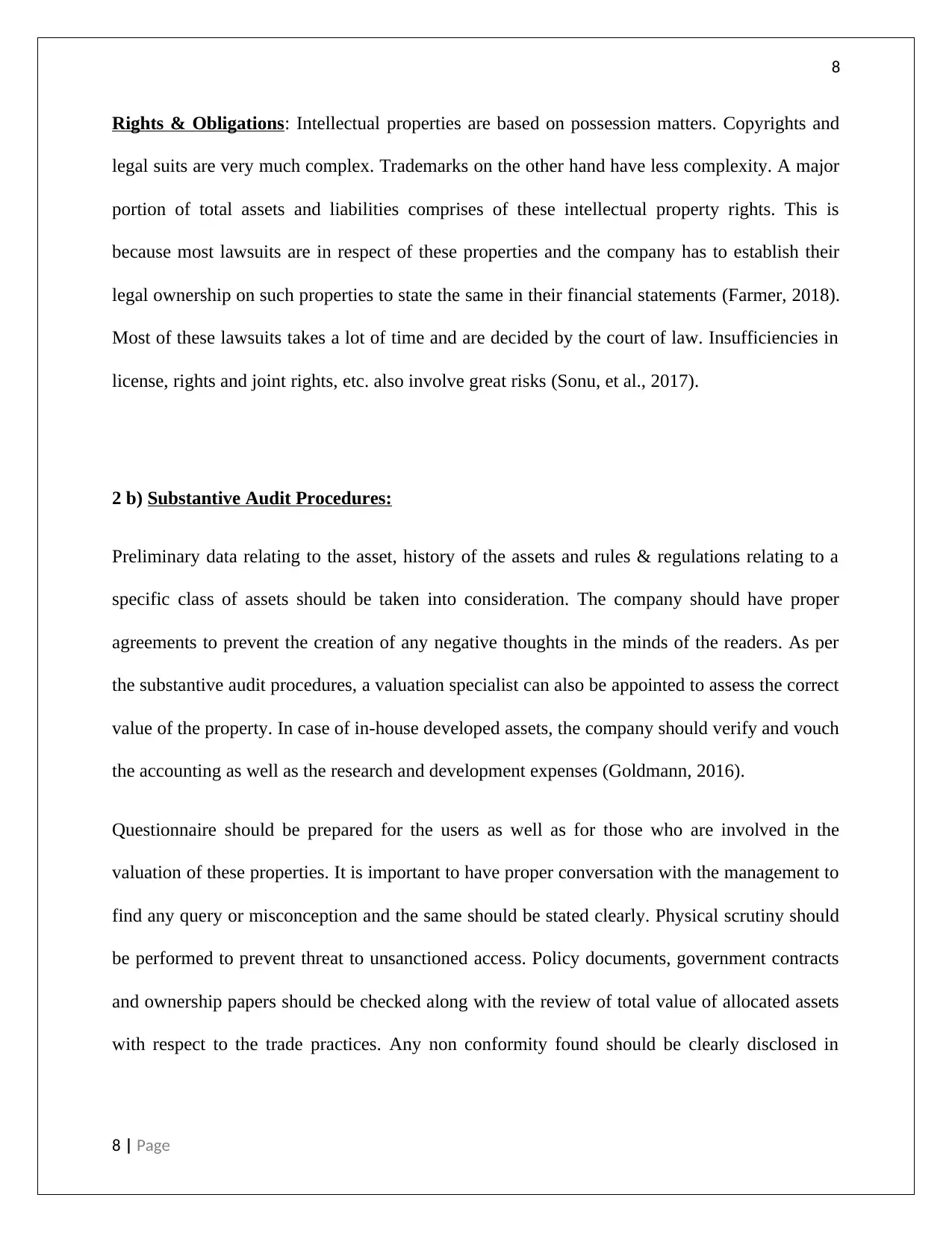
8
Rights & Obligations: Intellectual properties are based on possession matters. Copyrights and
legal suits are very much complex. Trademarks on the other hand have less complexity. A major
portion of total assets and liabilities comprises of these intellectual property rights. This is
because most lawsuits are in respect of these properties and the company has to establish their
legal ownership on such properties to state the same in their financial statements (Farmer, 2018).
Most of these lawsuits takes a lot of time and are decided by the court of law. Insufficiencies in
license, rights and joint rights, etc. also involve great risks (Sonu, et al., 2017).
2 b) Substantive Audit Procedures:
Preliminary data relating to the asset, history of the assets and rules & regulations relating to a
specific class of assets should be taken into consideration. The company should have proper
agreements to prevent the creation of any negative thoughts in the minds of the readers. As per
the substantive audit procedures, a valuation specialist can also be appointed to assess the correct
value of the property. In case of in-house developed assets, the company should verify and vouch
the accounting as well as the research and development expenses (Goldmann, 2016).
Questionnaire should be prepared for the users as well as for those who are involved in the
valuation of these properties. It is important to have proper conversation with the management to
find any query or misconception and the same should be stated clearly. Physical scrutiny should
be performed to prevent threat to unsanctioned access. Policy documents, government contracts
and ownership papers should be checked along with the review of total value of allocated assets
with respect to the trade practices. Any non conformity found should be clearly disclosed in
8 | Page
Rights & Obligations: Intellectual properties are based on possession matters. Copyrights and
legal suits are very much complex. Trademarks on the other hand have less complexity. A major
portion of total assets and liabilities comprises of these intellectual property rights. This is
because most lawsuits are in respect of these properties and the company has to establish their
legal ownership on such properties to state the same in their financial statements (Farmer, 2018).
Most of these lawsuits takes a lot of time and are decided by the court of law. Insufficiencies in
license, rights and joint rights, etc. also involve great risks (Sonu, et al., 2017).
2 b) Substantive Audit Procedures:
Preliminary data relating to the asset, history of the assets and rules & regulations relating to a
specific class of assets should be taken into consideration. The company should have proper
agreements to prevent the creation of any negative thoughts in the minds of the readers. As per
the substantive audit procedures, a valuation specialist can also be appointed to assess the correct
value of the property. In case of in-house developed assets, the company should verify and vouch
the accounting as well as the research and development expenses (Goldmann, 2016).
Questionnaire should be prepared for the users as well as for those who are involved in the
valuation of these properties. It is important to have proper conversation with the management to
find any query or misconception and the same should be stated clearly. Physical scrutiny should
be performed to prevent threat to unsanctioned access. Policy documents, government contracts
and ownership papers should be checked along with the review of total value of allocated assets
with respect to the trade practices. Any non conformity found should be clearly disclosed in
8 | Page
⊘ This is a preview!⊘
Do you want full access?
Subscribe today to unlock all pages.

Trusted by 1+ million students worldwide

9
details. For the valuation of these properties the company can also hire experts and also take their
opinion with regards to these properties.
2c) As per ASA 701, some matters which the Auditors think to be important for the users to take
decisions with respect to their investment in the company and which are important for the
company because of the risk element involved in them are required to be stated along with the
conformity of the elements of the financial statements, which is to be stated separately. All the
procedures undertaken by the Auditors for valuation of key audit matters and framing of
opinions on that should also be written separately (Heminway, 2017). The duty of the Auditor is
not to state important audit matters but to give his opinion on the Audit report. This is done by
them only to make the audit report more transparent for the users, and for the betterment of the
audit report. The auditors should exercise professional judgement on part of the entity. The
auditor can also disclose that certain matters which he feels are important for the users to take
their decision regarding the company has been stated as per his will and there is no mandate on
him for the disclosure of such matters (Sithole, et al., 2017). These matters help the Users to
analyse whether they have valued the property of the company correctly or not and whether the
company is correct or not. The management of the company should provide the auditors all the
information required for the successful conduct of audit and should support them in their work
(Kangarluie & Aalizadeh, 2017).
A lot of issues are involved in the valuation of intellectual property as it is a very complex
method. The Auditor should put more focus on these matters as a lot of justification and
provisioning is involved in this valuation. Substantive proof must be obtained from the company
by the auditor although, for the company, the existence of goodwill, know-how and expertise can
never be complete.
9 | Page
details. For the valuation of these properties the company can also hire experts and also take their
opinion with regards to these properties.
2c) As per ASA 701, some matters which the Auditors think to be important for the users to take
decisions with respect to their investment in the company and which are important for the
company because of the risk element involved in them are required to be stated along with the
conformity of the elements of the financial statements, which is to be stated separately. All the
procedures undertaken by the Auditors for valuation of key audit matters and framing of
opinions on that should also be written separately (Heminway, 2017). The duty of the Auditor is
not to state important audit matters but to give his opinion on the Audit report. This is done by
them only to make the audit report more transparent for the users, and for the betterment of the
audit report. The auditors should exercise professional judgement on part of the entity. The
auditor can also disclose that certain matters which he feels are important for the users to take
their decision regarding the company has been stated as per his will and there is no mandate on
him for the disclosure of such matters (Sithole, et al., 2017). These matters help the Users to
analyse whether they have valued the property of the company correctly or not and whether the
company is correct or not. The management of the company should provide the auditors all the
information required for the successful conduct of audit and should support them in their work
(Kangarluie & Aalizadeh, 2017).
A lot of issues are involved in the valuation of intellectual property as it is a very complex
method. The Auditor should put more focus on these matters as a lot of justification and
provisioning is involved in this valuation. Substantive proof must be obtained from the company
by the auditor although, for the company, the existence of goodwill, know-how and expertise can
never be complete.
9 | Page
Paraphrase This Document
Need a fresh take? Get an instant paraphrase of this document with our AI Paraphraser
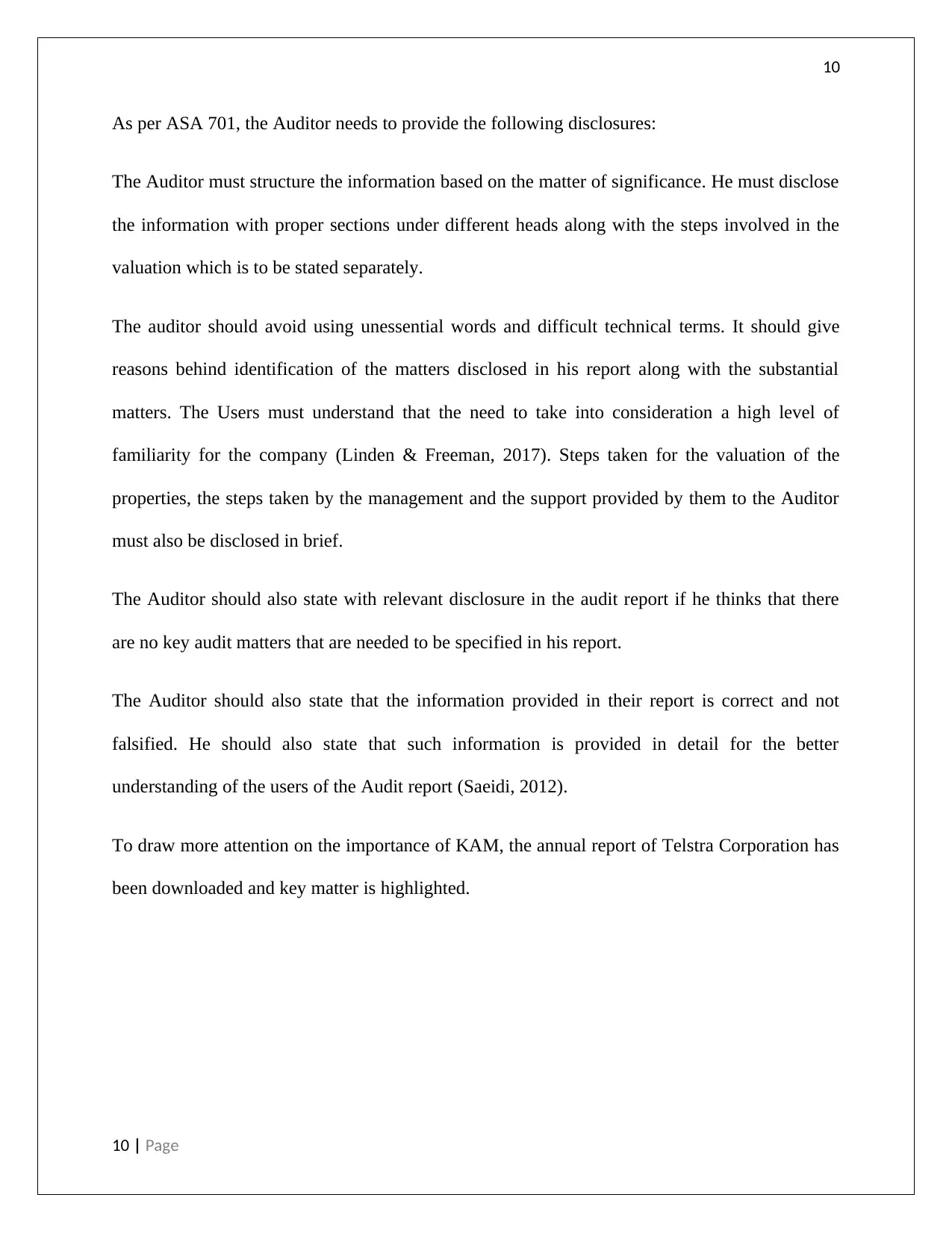
10
As per ASA 701, the Auditor needs to provide the following disclosures:
The Auditor must structure the information based on the matter of significance. He must disclose
the information with proper sections under different heads along with the steps involved in the
valuation which is to be stated separately.
The auditor should avoid using unessential words and difficult technical terms. It should give
reasons behind identification of the matters disclosed in his report along with the substantial
matters. The Users must understand that the need to take into consideration a high level of
familiarity for the company (Linden & Freeman, 2017). Steps taken for the valuation of the
properties, the steps taken by the management and the support provided by them to the Auditor
must also be disclosed in brief.
The Auditor should also state with relevant disclosure in the audit report if he thinks that there
are no key audit matters that are needed to be specified in his report.
The Auditor should also state that the information provided in their report is correct and not
falsified. He should also state that such information is provided in detail for the better
understanding of the users of the Audit report (Saeidi, 2012).
To draw more attention on the importance of KAM, the annual report of Telstra Corporation has
been downloaded and key matter is highlighted.
10 | Page
As per ASA 701, the Auditor needs to provide the following disclosures:
The Auditor must structure the information based on the matter of significance. He must disclose
the information with proper sections under different heads along with the steps involved in the
valuation which is to be stated separately.
The auditor should avoid using unessential words and difficult technical terms. It should give
reasons behind identification of the matters disclosed in his report along with the substantial
matters. The Users must understand that the need to take into consideration a high level of
familiarity for the company (Linden & Freeman, 2017). Steps taken for the valuation of the
properties, the steps taken by the management and the support provided by them to the Auditor
must also be disclosed in brief.
The Auditor should also state with relevant disclosure in the audit report if he thinks that there
are no key audit matters that are needed to be specified in his report.
The Auditor should also state that the information provided in their report is correct and not
falsified. He should also state that such information is provided in detail for the better
understanding of the users of the Audit report (Saeidi, 2012).
To draw more attention on the importance of KAM, the annual report of Telstra Corporation has
been downloaded and key matter is highlighted.
10 | Page

11
The auditor has considered impairment of the intangible asset as a key audit matter and making a
judgement. There is a lot of judgement involved on part of the management that including
valuation of future cash flows and other value in use models. Thus it can be said that it is a key
matter for the auditor of the company. The auditor has adopted the following audit procedures to
pass their judgement on these matters which includes checking the overall judgement applied by
the board in the calculation of the impairment, taking help from valuation specialists who has
helped the management of these assets for the company. The auditor has also applied test of
controls to see whether proper internal controls are in lace or not. All these steps have been taken
to express a judgement on the key audit matter.
References
11 | Page
The auditor has considered impairment of the intangible asset as a key audit matter and making a
judgement. There is a lot of judgement involved on part of the management that including
valuation of future cash flows and other value in use models. Thus it can be said that it is a key
matter for the auditor of the company. The auditor has adopted the following audit procedures to
pass their judgement on these matters which includes checking the overall judgement applied by
the board in the calculation of the impairment, taking help from valuation specialists who has
helped the management of these assets for the company. The auditor has also applied test of
controls to see whether proper internal controls are in lace or not. All these steps have been taken
to express a judgement on the key audit matter.
References
11 | Page
⊘ This is a preview!⊘
Do you want full access?
Subscribe today to unlock all pages.

Trusted by 1+ million students worldwide
1 out of 14
Related Documents
Your All-in-One AI-Powered Toolkit for Academic Success.
+13062052269
info@desklib.com
Available 24*7 on WhatsApp / Email
![[object Object]](/_next/static/media/star-bottom.7253800d.svg)
Unlock your academic potential
Copyright © 2020–2025 A2Z Services. All Rights Reserved. Developed and managed by ZUCOL.





